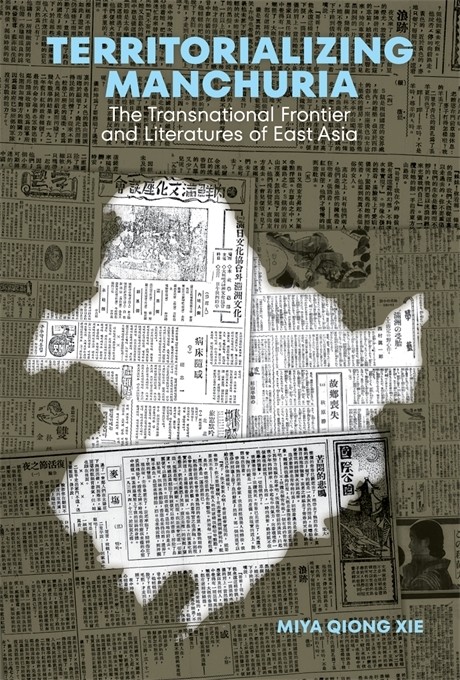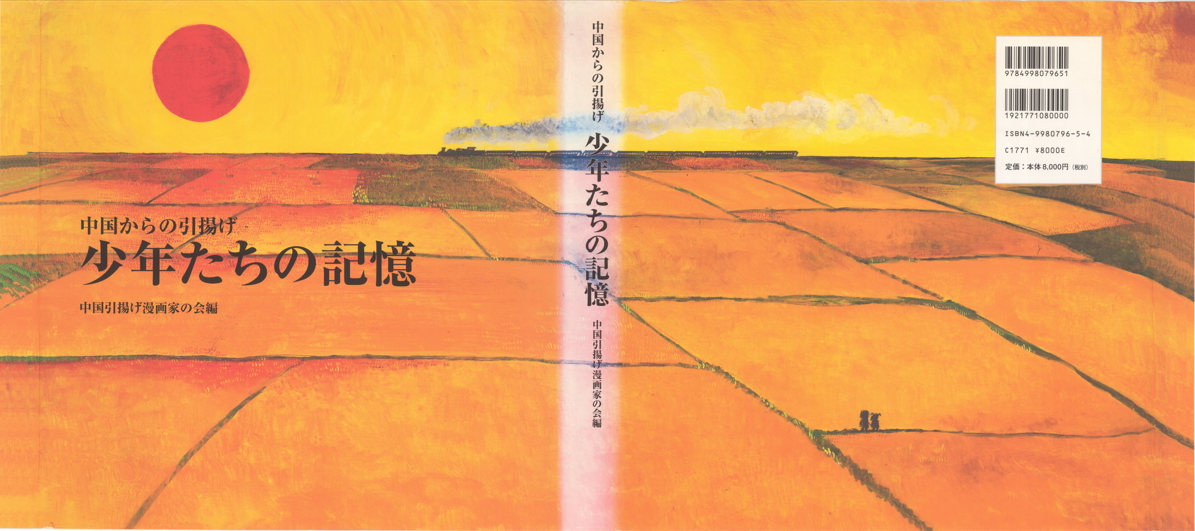WEAI Author Q&A: Miya Qiong Xie on "Territorializing Manchuria"

We are excited to announce a new title in the Studies of the Weatherhead East Asian Institute book series: Territorializing Manchuria: The Transnational Frontier and Literatures of East Asia, published by Harvard University Press. The book's author Miya Qiong Xie is an assistant professor of Chinese in the Asian Societies, Cultures, and Languages Program at Dartmouth College.
In Territorializing Manchuria, Miya Q. Xie reconceptualizes modern Manchuria as a critical site for making and unmaking national literatures in East Asia. Xie ventures into hitherto uncharted territory by comparing East Asian literatures in three different languages and analyzing their close connections in the transnational frontier. By revealing how writers of different nationalities constantly enlisted transnational elements within a nation-centered body of literature, Territorializing Manchuria uncovers a history of literary co-formation at the very site of division and may offer insights for future reconciliation in the region.
We thank Dr. Xie for taking the time to discuss her book with us.

Q: Territorializing Manchuria opens with a story about your experience as a literary studies student coming to realize the omnipresence and significance of Manchuria as a setting. Can you introduce Manchuria to us? What is the political/historical context for this motif(?) throughout Northeast Asian literature?
Manchuria sits where the Eurasian continent connects to the Pacific Sea and was once a contested frontier in Northeast Asia. When introducing Manchuria, different people would call it different things. The Manchus called the land Manju. For them, it was the sacred ancestral homeland. It was from there that they launched their conquest of China and established the Qing dynasty in 1644. For the Han Chinese, the land was and still is known as Dongbei, or the Northeast. Since the mid-nineteenth century, Han Chinese from the over-populated China Proper flooded into the region as agricultural migrants and quickly became the dominant population there. In 1911, after the Manchu regime collapsed, they rose to political dominance as well. The Japanese ventured into the game towards the end of the 19th century. They called the land Manshu, after the Manchus, to symbolically sever its ties with China proper. They desired the land because it was the lifeline of Japan’s imperial ambitions on the continent. To that end, they thwarted the Russian advance, pushed Chinese rulers aside, and set up a satellite state, Manchukuo, that lasted from 1932 to 1945. After WWII, Manchuria was remade into the Northeast of the newly born People’s Republic of China. Starting in the 1870s, Korean immigrants also carved out and maintained settlements along the Korean border as well, which prefigured the Korean Autonomous Prefecture of today’s PRC.
Q: Can you tell us a bit about the different conceptions of Manchuria across cultures? What does Manchuria look like to the Japanese reader, the Korean reader, and the Chinese reader?
That is a very good question. The full body of representations of Manchuria is diverse, and do not always align with national perspectives, so here I can only talk about the main currents. “Lifeline” is quite a good image of Manchuria in the Japanese eyes, especially when we think of the expansive railway network that they built there since the 1910a as the base of land control and expansion. In China, most Han Chinese people felt an antipathy towards Manchuria in the early twentieth century, first because it was the origin of the Qing dynasty that they sought to overthrow, and then, once that was achieved, Manchuria became an independent warlord kingdom that kept bringing trouble to China proper. But as Japan took over Manchuria in 1931 and its ambition for encroaching further into China proper became clear, Manchuria suddenly rose to be a land of significance that signified China’s “present and future, death or life.” In the Korean public space, Manchuria was most often represented as a destination for agricultural migration, where poor Korean farmers struggled in the interstice between Japanese imperialists and Chinese landlords. Meanwhile, some historians glorified the ancient time when Manchuria was being held by the Koryo Kingdom, the regional superpower, and considered Manchuria a territorial standard against which the “success” of the Korean nation could be measured.
Q: Could you introduce the concept of “literary territorialization”? How did your research lead you to develop this analytical lens?
The concept of “literary territorialization” consists of two parts: that literature territorializes and that literature is being territorialized. In the heat of territorial contestation among multiple peoples that I introduced above, writers identifying as Chinese, Korean, Japanese, Russian, and so on, were all writing in or about Manchuria but mostly wrote in their respective languages for their respective national readerships. So at first, I didn’t expect much in the way of interactions among these diverse bodies of writing. As I read the Chinese, Korean and Japanese texts side by side, however, I found that they exhibit a shared desire to claim a space for the nation. This space claiming could take the form of representing a geographical space in a way that makes it national; or carving out a linguistic or cultural space for the nation as an imaginary territory, or both. This was a dynamic and dialogical process that ultimately put the multi-lingual texts about Manchuria in overt or covert conversation with each other. In my book, I use “literary territorializes” to depict this dynamism.
In my book, I then use “literature is being territorialized” to depict the process by which modern literature in East Asia was demarcated by multiple institutions of national literary histories, especially in the postwar period. This answers my question about why, if Manchuria was such an important place for modern East Asian literature, I seldom saw it mentioned in my formal training in modern Chinese, Korean and Japanese literature. Modern literature is taught mostly through national literary histories, which are written from national perspectives. Manchuria is a peripheral place for all the modern nation-states surrounding it, so it is often marginalized in national literary histories from East Asia. Moreover, the transnational dynamism of frontier literature cannot be captured in full in any national literary history, and so it has been compartmentalized into different “national” pieces in different national literary histories. With the notion of “literary territorialization,” I hope to use the case of frontier literature to problematize the logic of territorializing literature along national lines in national literary histories.
Q: Can you introduce the writers whose works you feature? Why did you decide on these authors?
In the five chapters of my book, I introduce Chinese, Korean, Japanese and Taiwanese writers who have lived in Manchuria or wrote about Manchuria, or both. Because this book discusses how frontier literature contributes to the formation and problematization of national literatures in East Asia through the mechanism of literary territorialization, the works highlighted in the book have either been canonized in national literary histories of their respective languages, or have problematized existing forms of and discourses about national literatures, or both.
Chinese writers, especially Han Chinese writers, consciously presented Manchuria as first and fore most a Chinese space. But since Manchuria had been dominated by the Manchus, the Han Chinese, the Russians and the Japanese, it was not always easy for writers to quote political domination to show that Manchuria was a Chinese land. Instead, many writers favored native-soil literature, a modern Chinese literary genre that highlights the deep bond between people and land in rural China – recall that most Han Chinese in Manchuria started with agricultural immigrants from China proper. Their endeavor was quite successful, as the indigenous Chineseness of the land seems so natural in their work that most readers and critics so far have taken this Chinese Manchuria as a transparent, unmediated literary re-rendering of reality. In my book, I demonstrate that their work actually involves intensive creative labor to make Manchuria Chinese, or a process of territory-making, which affected many thematic and stylistic choices the authors made that led to the literary success of their work.
In a different chapter, I study a so-called “collaborationist writer,” Gu Ding, who was active in Manchukuo and close to the Japanese, focusing on his experiment with a hybrid language that mixes elements of Japanese and multiple forms of Chinese languages in his vernacular Chinese writing. Instead of choosing sides by defining him as either a pro-Japanese or a pro-Chinese writer, I show how he used the linguistic experiment to construct a multi-national connectivity around his literary work and to consequently maximize Chinese cultural territory under the political domination of a cultural other. For him and many other frontier subjects, preserving or expanding a national cultural territory often involves compromising some less essential – in their eyes – elements in the national culture. This mechanism of frontier territorialization challenges the binary between nationalist and collaborative literature that has long hindered studies of colonial literature in East Asia.
In the Korean group, I introduce Kim Tong-in’s Manchuria-themed short story “The Red Hills,” a long-time canonical piece of nationalist literature in South Korea. The story capitalizes on the long-standing image of the pathetic Manchurian Korean farmers being oppressed by both the Chinese landlords and the Japanese imperialists to arouse nationalist sentiment among Korean readers. My comparative study of the original work from the 1930s and its Japanese and Chinese translations in the 1940s, however, shows that the three versions of the same story, when translated and anthologized in three languages, were used to speak for the three countries’ respective, and mutually conflicting claims to the same frontier of Manchuria. This case study shows both the significance, and the ambiguity, of using a contested frontier for nationalist territorialization in modern literature. The same ambiguity applies to a group of Korean writers who moved to Manchuria in the 1930s and wrote there until 1945. In contrast to writers in Korea who were pressured to write in Japanese in the late colonial period, writers in Manchuria were allowed to write in Korean throughout Manchukuo regime under Manchukuo’s ideological umbrella of ethnic harmony. Was their Korean writing a form of linguistic nationalism, or, to use my term, a form of linguistic territorialization? If so, how far could it go? Here again, I examined the literary translation of their work to answer these questions.
There had been abundant literary production about Manchuria in Japanese by Japanese writers based both in Japan and in Manchuria ever since the 1900s; in the 1940s, some Korean writers who self-identified as Japanese or wrote in Japanese also joined the flood of Japanese writing about Manchuria. My focus in Japanese writing in my book, however, is on the singular and iconic postwar Japanese writer Abe Kōbō, who spent the first twenty some years of his life in Manchuria until the end of the war and subsequently developed a sophisticated “border thought” in his early postwar writing. The choice is first because pre-1945 Japanese writing about Manchuria has been relatively well-studied by many other scholars, and second because the relationship between Abe Kōbō’s Manchurian experience and his early postwar writing presents an excellent case of how 1) the significance of frontier to the formation and problematization of national literature did not cease in 1945 but lingered into the postwar period; and 2) this multinational frontier, though it was subjected to Japanese colonial domination, cannot be fully grasped through a binarized structure of the colonizer and the colonized, but has more a complicated national and ethnic dynamism. Only when we move beyond the colonial binary can we appreciate the full implications of Abe’s frontier experience on his postwar border thought.
In the epilogue of my book, I examined the Taiwanese writer Zhong Lihe’s Manchuria-themed works in comparison to his Taiwan-themed works. Zhong moved from Japanese colonial Taiwan to Japanese colonial Manchuria in 1938 and started literary writing there. His Manchuria-themed works, however, were mostly unfinished or fragmental, epitomizing some of the formal difficulties in territorializing a multi-national frontier in the form of national literature, difficulties that many other authors discussed in the book also encountered. By reading the author’s Manchuria-themed and Taiwan-themed work comparatively, I also explore what I call a cross-frontier approach – the approach of studying literature from different frontiers in light of each other – since Zhong considers his Hakka hometown in Taiwan, too, to be a frontier in many senses.
Q: Beyond Manchuria, what other regions or territories warrant further study through the analytical lens of literary territorialization? [Can you share any contemporary examples of works that beg further study, perhaps within currently contested territories of Northeast Asia?]
I have students who used the concept of literary territorialization to study Southeast Asian Sinophone literature, Chinese ethnic minority literature, and the linguistic landscape in Israel. In retrospect, I think this concept is useful not only for places with territorial contestation in the geographical sense, but also for places with contestation for imaginary territories, such as cultural, linguistic, and literary territories. In those places, writers who are situated in precarious linguistic or cultural conditions often try hard to claim more space for their languages or culture through literary writing. The dynamism of literary territorialization is especially visible when there are not just one dominating and one dominated party, but multiple parties competing with each other.
Theoretically, I consider literary territorialization a critical reflection on the concept of borderland literature as it is now known in academia. Frontier and borderland are different concepts, which I discuss in detail in my book. But if you are familiar with the discourse of borderland literature as an emancipatory literature that comes with the promise of resisting the center, overcoming the border, and disrupting the order of the nation-state or the empire, then the notion of literary territorialization captures a different landscape at those divided locations. Inasmuch as territorialization in contestation is a dynamic process, the borders are constantly crossed, shifted, disrupted, or negotiated, but are often also reestablished. In this schema, a border is sometimes crossed only so that it can be pushed or strengthened further, and a center is resisted only so that it can be shifted elsewhere. Border-crossing as such may problematize existing orders in some ways, and sometimes beyond authorial intention, but one cannot easily say that it overcomes or transcends the border; instead, it is entirely possible that inequality and domination only gets reinforced, or exacerbated, when a border is crossed.
Q: What was the most memorable depiction of Manchuria across the works you studied? [Or what was the most surprising finding from your research?]
The most memorable depiction of Manchuria across the works I studied was a visual depiction that I did not get to include in my book. It is the cover page of the book Repatriation from China: Memory of the Youth by Morita Kenji. The scene of a train traversing the boundless Manchurian plain against burning sunset appears repeatedly in his work, which he recalls to be the last scene he saw in Manchuria as he travelled back to Japan as a child in 1946. The image can however be interpreted in many other ways: the fertile land has repeatedly appeared in Chinese, Korean, and Japanese writers’ work, containing the hard work of agricultural reclamation by their fellow-country men; the railway was seen as the icon of Japanese colonial development and expansion in Manchuria; and the sunset may allude to the fall of the Japanese empire, having been symbolized by the flag of a rising sun. This image, simple but rich in symbolism, can lend itself to numerous interpretations by conflicting parties, who have collectively inhabited this same space and made a life for decades. So I often gaze at this image, imagining different groups of people gazing at it as a collective, feeling both a tension and a connection to each other. Ultimately, my book is about the possibility of formation in contestation, in both the past and future of East Asia.

